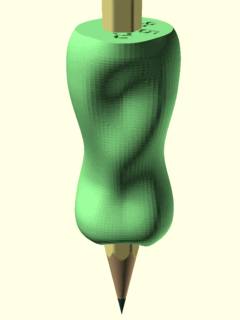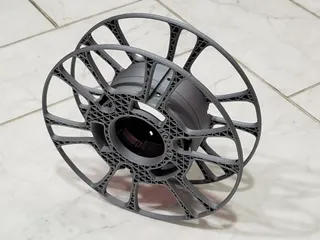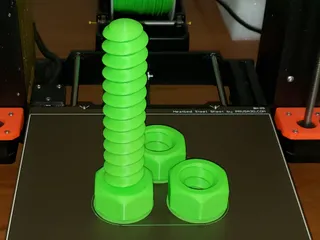Ergonomic children's pencil holder for Chinese writing
Description
PDF
This ergonomic pencil holder is based on a research study to develop an optimal design for students learning to write Chinese characters. Writing Chinese typically uses a different grip compared to western writing.
For western writing, in fact, I find this pencil holder downright uncomfortable! If you write Chinese, however, it's great. My son, who has been learning to write Chinese, says it helps him write better. The research study also reported that students using this pencil holder demonstrated improved penmanship.
Customizing
Files are included in several sizes, for left-handed and right-handed students, covering hand lengths from 140 mm to 188 mm. Hand length is measured from the tip of the middle finger to the first crease of the wrist.
To customize your own, load the .scad file into OpenSCAD. In the Customizer window, set the handlen parameter to the length of the hand. The average lengths called out in the study were 139 mm for school children in low grades, 150 mm for mid-grades, and 162 mm for high grades. I'm an average adult with a hand length of 185 mm.
Other parameters set the pencil thickness, left-handedness, and tightness around the pencil. The size and handedness (L or R) are engraved on the larger end. The smaller end goes toward the tip of the pencil.
Reference
Wang, Ching-yi & Cheng, Zi-Tao. (2023). Design and Assessment of Children's Pencil Holder for Chinese Writing. Sustainability 15(16):12421. DOI 10.3390/su151612421.
Print settings
Printer: Prusa I3 MK3S
Supports: No
Resolution: 0.6 mm nozzle, 0.2-0.3 mm layers, 2 perimiters
Infill: 10% gyroid
Filament: SainSmart TPU 87a (transparent)
Notes:
- Print with a flexible material such as TPU or flex PLA, ideally with a durometer hardness less than 90a.
- Use no more than 2 perimeters and 10% gyroid infill. More than that makes it too stiff to slip over a pencil. Even with 87a durometer TPU, it came out fairly stiff.
- Using a 0.6 mm nozzle can make the difference between a failed print and successful print, when using TPU.
- No brim is needed for TPU even though the slicer might give a print stability warning. Use a release agent like hair spray or a glue stick to avoid damaging your build plate. Painting some isopropyl alcohol around the bottom edge also helps release the part.
Post-printing
After printing, rub some wax on the pencil where this holder will go. Use a crayon or a candle. Only then can you slide it onto the pencil. If you don't use wax, you may find it impossible to remove the holder after it has settled onto the pencil for a few hours.
Install with the smaller end toward the tip.
How I designed this
I did this completely in OpenSCAD without any external libraries. This was the first time I designed something with a double-Bezier curved surface. Bezier curves define the multiple elevation profiles at different rotation angles, with closed-loop Bezier curves making horizontal cross sections at each elevation point. The .scad file is "V2" (version 2) because originally I tried double Akima splines but found that Akima splines don't work well for constructing surfaces because they introduce surface discontinuities between the initial splines used to determine the orthogonal splines.
The same authors who did the research on this pencil holder also did the research on which my ergonomic handle model is based. I used that handle to design my over-engineered pullcopter.
Category: Learning
Tags
Model origin
The author marked this model as their own original creation. Imported from Thingiverse.




